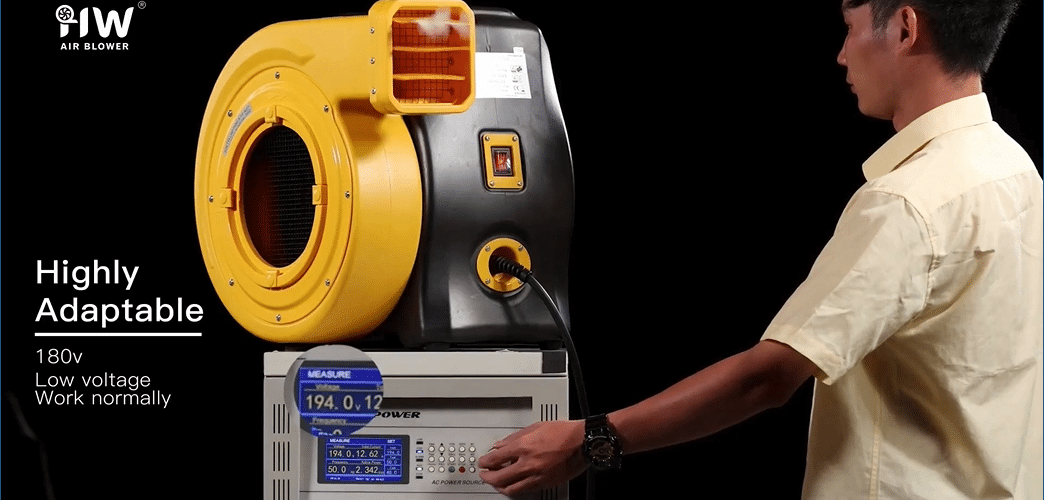
Boost Efficiency with Huawei Air Blowers: A Step-by-Step Guide for Inflatable Setups
Huawei air blowers are designed to streamline inflatable setups, making it easy to achieve quick, stable inflation for events. By following these step-by-step tips, you can boost setup efficiency, maintain safety, and ensure reliable performance for various inflatable types. Here’s how to get the most out of your Huawei air blowers for an efficient and successful event.
Step 1: Select the Right Blower for Your Inflatable Size
Matching the blower to the inflatable’s size ensures optimal airflow and inflation speed. Huawei air blowers come in various models, each suited to different inflatable sizes, from small bounce houses to large obstacle courses.
Blower Selection Guide
- Eco-1000: Ideal for small inflatables up to 10×10 feet, providing efficient inflation without excessive power use.
- HP-1200: Suitable for medium-sized inflatables, such as bounce houses or slides up to 15×15 feet.
- HP-1600 Pro: Perfect for large inflatables, offering maximum airflow for obstacle courses and larger structures.
Step 2: Position the Blower on a Stable Surface
Ensure the blower is placed on a flat, stable surface close to the inflatable’s air intake. Proper placement prevents tipping and optimizes airflow, allowing for faster, safer inflation.
Positioning Tips
- Choose a Level Surface: Position the blower on stable, even ground to prevent it from shifting during operation.
- Avoid High-Traffic Areas: Place the blower away from guest walkways to minimize accidental interference.
Step 3: Secure the Blower to the Inflatable Intake
Connect the blower’s nozzle to the inflatable’s air intake and ensure a tight seal using the intake strap. This prevents air leaks and maintains steady airflow for consistent inflation.
Connection Tips
- Align the Nozzle: Position the blower’s nozzle directly with the inflatable’s intake to ensure maximum airflow.
- Tighten the Strap: Use the intake strap to secure the blower nozzle firmly, avoiding any gaps that could cause air leaks.
Step 4: Use a Dedicated Power Source
To ensure the blower receives consistent power, plug it into a dedicated outlet or use a heavy-duty extension cord. This setup prevents voltage drops, which can hinder blower performance.
Power Source Tips
- Dedicated Circuit: Use a separate outlet for the blower to avoid sharing power with other equipment, preventing circuit overload.
- Heavy-Duty Extension Cord: Choose an outdoor-rated 12- or 14-gauge extension cord if needed, ensuring steady power delivery.
Step 5: Inflate the Structure and Monitor Progress
Turn on the blower and let it fully inflate the structure, monitoring for any areas that may need adjustment. Properly inflated inflatables are firm and secure, providing a safe environment for users.
Monitoring Tips
- Check for Full Inflation: Ensure the inflatable is firm and maintains its intended shape, adjusting airflow if needed.
- Inspect for Air Leaks: Listen for any hissing sounds around the intake or seams, which may indicate a leak.
Step 6: Secure Cords and Cables to Minimize Tripping Hazards
Keep power cords safely positioned and secured to avoid creating tripping hazards in high-traffic areas. Use cord covers or tape to keep them out of walkways and accessible only to staff.
Cord Safety Tips
- Use Cord Covers: Cover power cords with protective covers, especially if they cross pathways.
- Anchor with Tape: Use tape to secure cords in place, reducing movement and accidental disconnections.
Step 7: Maintain the Blower During Use
In high-demand events, periodically check the blower’s condition to prevent overheating and ensure optimal performance. Monitoring helps avoid unexpected interruptions and keeps the inflatable safely inflated.
Maintenance Tips
- Check Temperature: Periodically touch the blower’s casing to ensure it’s not overheating. Allow the blower to cool down if it feels too hot.
- Listen for Unusual Sounds: Unusual sounds may indicate issues with the motor or airflow. Investigate immediately to avoid further problems.
Step 8: Deflate the Structure Safely When the Event Ends
To deflate, turn off the blower and allow the inflatable to collapse naturally. Avoid disconnecting the blower forcefully to protect both the blower and inflatable.
Deflation Tips
- Power Down First: Turn off the blower before detaching it from the inflatable to ensure a controlled deflation.
- Remove Carefully: Detach the blower nozzle gently to avoid damage to the blower or intake port.
Step 9: Store the Blower and Inflatable Properly
After the event, clean and store the blower in a cool, dry area. Proper storage helps maintain the blower’s performance for future use.
Storage Tips
- Clean the Blower: Wipe down the blower’s exterior and clear any dust or debris from vents.
- Use a Cover: Place a cover over the blower to protect it from dust and accidental damage while in storage.
Efficient Inflatable Setup with Huawei Air Blowers
Following these steps will help you maximize efficiency and safety when using Huawei air blowers for inflatable setups. By ensuring secure connections, consistent power, and proper storage, you can provide a reliable and enjoyable experience for every event.
Boost event efficiency and keep your Huawei air blowers performing at their best with this step-by-step guide for inflatable setups!